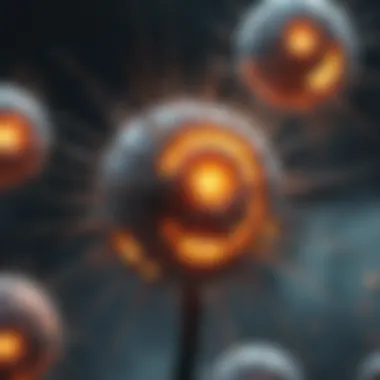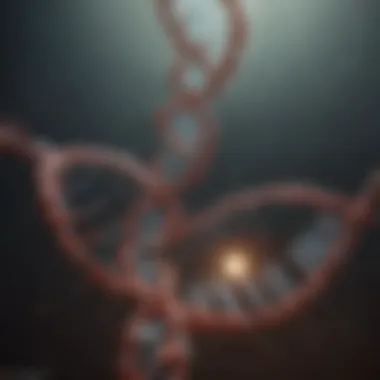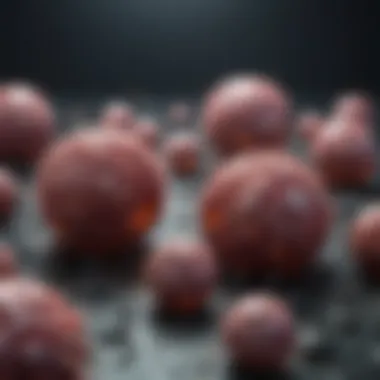Understanding Mechanisms of Radiation-Induced Cell Death


Overview of Research Topic
Brief Background and Context
Cancer treatment has evolved remarkably over recent decades, with radiation therapy standing out as a significant player. This particular method capitalizes on high-energy particles or waves to rid the body of cancerous cells. What lies beneath this seemingly straightforward treatment, however, is a web of complex biological interactions that invoke cell death in various forms. Understanding how radiation inflicts damage on cells, specifically at the DNA level, is fundamental for both scientists and clinicians alike.
Cells are the building blocks of our body, and the delicate balance that maintains their life can be readily disrupted by radiation. The primary damage occurs when radiation interacts with the DNA, leading to molecular lesions that can either trigger a cascade of cellular responses or lead to outright cell demise. Knowing the specifics helps researchers optimize treatment protocols and mitigate side effects, thus improving patient outcomes.
Importance in Current Scientific Landscape
The exploration into how radiation induces cell death cannot be overstated in the realm of oncology research. As we stand at the crossroads of advancing treatment techniques, knowing the intricacies of these mechanisms opens doors to novel therapy combinations. It's not just about exterminating cells; the depth of understanding provides a pathway for personalized treatment strategies that cater to individual patient needs, taking into account tumor type, genetics, and overall health profile.
"Unlocking the mysteries of radiation therapy is akin to deciphering a language that speaks directly to the cellular nucleus, revealing pathways for improvement in cancer management."
Methodology
Research Design and Approach
To get to the bottom of these processes, a multifaceted approach is key. Instead of relying solely on one methodology, interdisciplinary collaboration is encouraged. This means integrating molecular biology techniques with advanced imaging modalities and computational models. By combining these strategies, researchers may dissect the myriad of responses that cells exhibit upon exposure to radiation.
Data Collection Techniques
Understanding these methodologies not only enhances the effectiveness of radiation therapy but also contributes to a broader scientific discourse that can lead to more innovative treatment strategies.
Prologue to Radiation Biology
Radiation biology is a vital field that explores how different forms of radiation interact with living tissues. At the core of this subject lies an essential understanding of how radiation induces various forms of cell death, notably in cancer treatment. The significance of radiation biology cannot be overstated; it interrogates the mechanisms that underpin radiation effects on cellular structures and helps us comprehend how these processes can be harnessed for therapeutic gain.
Furthermore, by dissecting the intricacies of radiation’s actions on cells, researchers can devise optimized protocols that enhance therapeutic effectiveness while mitigating unwanted side effects. This exploration touches upon key elements essential to both researchers and practitioners:
- Understanding the types of radiation and their biological impacts.
- Recognizing the historical development of radiation therapy as an oncological approach.
- Fostering an appreciation for the ongoing evolution of research in this domain.
In summary, the study of radiation biology provides a lens through which we can view the underlying principles guiding radiation therapy, framing a narrative that intertwines scientific discovery with clinical application. As we navigate through this discourse, we will delve into the nuances of Understanding Radiation Types and explore the Historical Context of Radiation Therapy, thereby laying a groundwork for understanding how radiation kills cancer cells.
Mechanisms of Radiation Damage
The mechanisms of radiation damage are fundamental for understanding how radiation therapy works in the context of cancer treatment. This section sheds light on the intricacies behind how radiation impacts cellular structures, particularly DNA, and informs the broader discussion on effective treatment strategies in oncology. By grasping these mechanisms, researchers and practitioners can refine radiation therapies and enhance patient outcomes. The investigation here isn't just academic; it has vital clinical implications that could shape future methodologies.
Direct and Indirect Effects of Radiation
Definition of Direct Effects
Direct effects of radiation occur when radiation particles collide with cellular components, leading to immediate alterations. Essentially, if a photon hits a molecule, it can directly knock electrons out, resulting in a cascade of ionizations. This phenomenon highlights a key characteristic: the immediacy of the damage. Direct damage often leads to severe outcomes, such as mutations or cell death due to the significant alteration of essential biological molecules.
In the context of this article, understanding direct effects is crucial because it provides insight into the cellular vulnerabilities exposed during radiation therapy. Unique to this aspect is the rapidity with which damage manifests, allowing for a clearer mapping of the potential efficacy of treatment doses. However, while direct effects might result in swift cellular death, they may not be as favorable in terms of targeting specific tumor cells effectively, as normal surrounding tissues can suffer collateral damage.
Definition of Indirect Effects


Unlike direct effects, indirect effects stem from the radiation's interaction with water molecules surrounding cells. This interaction produces reactive oxygen species (ROS), which can lead to significant DNA damage without direct contact with radiation. The key characteristic of the indirect effects is its pervasive nature; since about 70% of human cells are water, this pathway plays a substantial role in overall cellular responses to radiation exposure.
This aspect is particularly advantageous in scenarios where direct radiation exposure is limited. By generating ROS, indirect effects have the potential to affect a wider area and can induce apoptosis in adjacent cells, which is relevant for targeting cancer cells spread throughout a tissue. However, the disadvantage here is the unpredictability of the oxidative damage incurred, leading to challenges in quantifying treatment efficacy and potential side effects.
DNA Damage and Repair Mechanisms
Types of DNA Damage
Radiation can inflict various types of damage on DNA, primarily categorized as single-strand breaks (SSBs) and double-strand breaks (DSBs). SSBs occur when one of the DNA strands is broken, while DSBs represent a more severe form of damage where both strands are severed. The distinguishing feature of DSBs is their propensity to lead to catastrophic cellular events if not properly repaired.
The prominence of studying these types in this article lies in their direct correlation with cell lethality after radiation exposure. DSBs are particularly problematic because they often result in cell-cycle arrest, apoptosis, or malignant transformations if repair mechanisms are unsuccessful. These characteristics underline why deep-diving into types of DNA damage is pivotal for understanding treatment outcomes.
Cellular Repair Processes
Cells possess complex mechanisms to identify and repair DNA damage, including homologous recombination and non-homologous end-joining pathways. Each of these processes plays a crucial role in determining cellular fate post-radiation exposure. The key feature here is efficiency—the proficiency of repair mechanisms significantly impacts whether a cell can recover or perish.
Understanding these processes enriches the discussion within the article by highlighting potential therapeutic targets. For instance, inhibiting repair processes in tumor cells could increase their susceptibility to radiation. A unique attribute of these cellular repair pathways is that they exhibit variable efficiency among different cell types, which can determine radiotherapy outcomes in individual patients.
Limitations of Repair Mechanisms
While cellular repair mechanisms offer a means to recover from radiation damage, they are not infallible. Certain limitations can impede effective repair, such as the severity of damage, the overall health of the cell, and factors like hypoxia. The key characteristic of these limitations is their unpredictability; not every cell will mount a successful repair response, potentially leading to the survival of a population of damaged but viable cells.
Identifying these limitations is paramount within this article as it points to why some tumors may recur post-treatment. The unique feature here is that the effectiveness of repair can vary not just between different cell types, but also within a single tumor, complicating efforts to gauge therapy effectiveness.
Cellular Stress Responses
Activation of Cell Cycle Checkpoints
Cell cycle checkpoints serve as a safeguard system, ensuring that cells do not proceed through the cycle with unrepairable DNA damage. The activation of these checkpoints can halt cell cycle progression, providing time for repair mechanisms to rectify issues before replication. Here, the most significant characteristic of these checkpoints is their timeliness; detection of damage can mean the difference between survival and programmed cell death.
In the context of radiation therapy, understanding checkpoint activation is essential. If cancer cells can evade these checkpoints, they might proliferate despite radiation. This aspect makes it a valuable subject within this article as it opens avenues for combining therapies to enhance radiation efficacy. However, a unique drawback is that prolonged activation can lead to senescence, potentially allowing damaged cells to persist and become problematic later.
Apoptosis vs. Necrosis
Apoptosis and necrosis represent two divergent forms of cell death triggered by radiation, each with distinct characteristics. Apoptosis is a tidy, regulated process leading to cell dismantling without inflammation, while necrosis is messy, often resulting in inflammation due to cellular lysis. The stark difference is significant in the realm of radiation therapy.
Understanding these two forms of cell death is beneficial as it can inform therapeutic strategies. For example, promoting apoptosis while minimizing necrosis can lead to more efficient tumor cell eradication with less collateral damage to healthy tissues. However, a unique challenge arises with necrosis; its inflammatory response might provoke surrounding cells, potentially leading to further adverse effects on treatment efficacy.
Factors Influencing Radiation Efficacy
The efficacy of radiation therapy is not a straightforward matter; it's riddled with complexities that can significantly affect outcomes. The factors influencing radiation efficacy are pivotal as they dictate how effectively radiation can damage cancer cells while limiting harm to surrounding healthy tissues. In this section, we will explore various elements such as cellular characteristics, radiation dose and energy, and the role of oxygen in determining how well radiation works in different scenarios.
Cellular Characteristics
Cell Cycle Stage
The cell cycle is a fascinating aspect. Cells progress through various phases—G1, S, G2, and M—each offering a unique window of susceptibility to radiation. Cells in the M phase, for instance, tend to be more vulnerable because they are in the process of dividing. This characteristic makes targeting them during this stage beneficial in radiation therapy. Conversely, cells in the G1 phase are typically more resistant. This differing sensitivity is crucial for oncologists tailoring treatment plans.
The advantage of focusing on cell cycle stages allows for optimizing the timing of radiation exposure. Understanding which phase a tumor's cells are in can help maximize cell kill rates while minimizing side effects. However, one limitation lies in accurately determining the precise cell cycle phase of individual tumor cells during treatment.


Genetic Alterations
Genetic changes within tumor cells can significantly influence how they respond to radiation. Mutations in certain genes, like the p53 tumor suppressor gene, can lead to increased resistance. When p53 is dysfunctional, cells may evade normal apoptotic signals, making them harder to kill with radiation.
Highlighting key genetic alterations helps in designing personalized treatment approaches, as certain genetic profiles might respond better to radiation than others. This factor adds a layer of complexity because not all patients will have the same genetic background, which necessitates a tailor-made therapeutic approach. The unique feature here is the capacity to potentially use genetic profiling to inform treatment regimens, offering a personalized avenue that maximizes efficacy. However, it's also important to note that not all genetic alterations are well understood, complicating their integration into clinical practice.
Radiation Dose and Energy
Low vs. High Dose Effects
Radiation doses can be broadly categorized into low and high dose effects, each presenting different biological responses. At lower doses, cells might experience sub-lethal damage, allowing for the possibility of repair, while higher doses can overwhelm cellular repair mechanisms and induce lethal conditions.
The balance between these effects is crucial for effective treatment. Calculating the right dose to deliver can mean the difference between success and failure in therapy. High doses can lead to immediate cell death and should be approached with caution due to the risk of collateral damage to healthy tissues.
One unique element here is the therapeutic window—the dose range within which cancer cells can be effectively targeted while sparing normal cells. Getting the dose right can be challenging due to individual differences in tissue sensitivity, requiring ongoing assessment and adjustment during treatment.
Dose Rate and Fractionation
Dose rate and fractionation refer to how the total radiation dose is divided and administered over time. Low dose rate irradiation allows for more time for cells to repair, potentially decreasing the effectiveness of the treatment. Conversely, higher dose rates can lead to greater immediate effects on tumor cells.
Fractionation, which involves administering doses in smaller increments over a period, has its own set of advantages. This approach can exploit the differential recovery capacities of normal and tumor cells, potentially enhancing therapeutic outcomes while minimizing side effects. The unique feature of this method lies in its ability to provide both biological protection to normal tissues and aggressive targeting of tumor cells. However, careful planning is necessary to ensure that each fraction remains effective, as errors can accumulate with multiple sessions.
Oxygen Effect and Hypoxia
Role of Oxygen in Radiation Response
Oxygen plays a critical part in radiation therapy. Tumor cells in well-oxygenated environments tend to be more susceptible to therapy due to a phenomenon known as the oxygen enhancement ratio. When radiation interacts with oxygen, it produces free radicals that further damage DNA and cellular structure, enhancing overall therapeutic efficacy.
Focusing on the role of oxygen allows for strategic adjustments in treatment. Enhancing oxygen supply, such as through hyperbaric oxygen therapy, could potentially improve radiation response. Nevertheless, not all tumors are well-oxygenated, and overcoming hypoxic conditions presents challenges in effective treatment delivery.
Consequences of Tumor Hypoxia
Tumor hypoxia can severely impact treatment outcomes. Hypoxic tumor regions can possess a strong resistance to radiation, reducing the overall effectiveness of therapy. Cells in these hypoxic areas are often in a state of low metabolic activity and can survive high doses of radiation, complicating treatment.
Highlighting the consequences of this hypoxia emphasizes the need for adaptive therapeutic strategies. Biopsies and imaging can help assess oxygen levels and inform interventions that might improve outcomes. These include combinations of therapies aimed at improving tumor oxygenation. However, designing such strategies requires sophisticated planning, as the interplay between treatment methods can introduce new complications.
In summary, understanding the multifaceted factors influencing radiation efficacy is essential for developing successful treatment protocols. Each element—from cellular characteristics to the nuances of radiation dose and the impact of oxygen—plays a crucial role in achieving desired therapeutic outcomes.
Clinical Implications of Radiation-Induced Cell Death
The mechanisms involved in radiation-induced cell death hold critical relevance in oncology. Understanding how radiation affects cellular structures can directly influence treatment protocols, optimizing patient outcomes. As a key modality in cancer treatment, the ability of radiation to induce cell death through various biological processes unfolds a complex landscape of opportunities and challenges for clinicians and researchers.
The implications of these mechanisms can be far-reaching. First and foremost, knowing the specific actions of radiation on cells can help in tailoring therapies to individual patients. This personalization is increasingly vital in the fight against cancer, as each type of tumor may respond differently to radiation. Overall, this section seeks to delve into the utility of radiation in clinical practices, highlighting its applications, adverse effects, and future directions that can further refine cancer treatment strategies.
Applications in Oncology
Radiation Therapy Protocols
Radiation therapy protocols can be seen as the backbone of cancer treatment regimens. These protocols outline how radiation is administered, focusing on dosages, treatment intervals, and specific radiation techniques used. A noteworthy aspect of these protocols is their dose optimization – ensuring that tumor cells receive enough radiation to induce cell death while sparing surrounding healthy tissues.


The key characteristic of these protocols lies in their adaptability. Different cancers react variably to radiation doses, necessitating a tailored approach. For example, some tumors may require a high dose delivered in a short span, whereas others are treated better with lower, fractionated doses over time. This adaptability makes radiation therapy a preferred option within oncological treatment. Unique features of these protocols, like image-guided radiation therapy (IGRT), enhance precision, allowing better targeting of tumor locations and improved control of radiation exposure to healthy tissues. On the downside, there is a risk of overexposure and potential radiation damage to the adjacent healthy organs, leading to treatment modalities that must constantly be evaluated.
Combining Therapies for Enhanced Efficacy
A growing strategy in oncology is the combining of therapies with radiation, aimed at amplifying therapeutic outcomes. When used alongside chemotherapy or immunotherapy, radiation can create a synergistic effect. By understanding the cellular responses to radiation, oncologists can time the administration of drugs when the tumor cells are most vulnerable following radiation exposure.
One key characteristic of this combined approach is the enhanced efficacy it can offer. For instance, utilizing chemotherapeutic agents that sensitize tumor cells to radiation can result in improved response rates. This unique feature of synergy brings forth several advantages, such as decreased tumor size and possibly improved survival rates. Conversely, this combined modality can also amplify side effects, as patients may experience more pronounced acute and long-term effects due to the intensified treatment.
Radiation Side Effects
Acute and Late Effects
Awareness of acute and late side effects is crucial for patient management. Acute effects, which tend to manifest shortly after treatment, can include skin irritation, fatigue, and localized pain. Understanding these effects is essential since they can significantly impact a patient's quality of life during treatment. On the other hand, late effects may arise months or even years after treatment, including complications like secondary cancers or fibrosis of irradiated tissues.
The notable characteristic of these effects lies in their timing and variability. Not all patients will experience the same side effects, which calls for a tailored approach to patient care. The unique feature here is that while acute effects may resolve, late effects are often more detrimental and challenging to manage. Thus, a balance must be struck between achieving effective treatment and minimizing harm to the patient.
Management of Side Effects
Effective management of side effects is paramount to improve the overall experience and outcomes of cancer treatment. Supportive therapies, such as using corticosteroids to mitigate inflammation or nutritional support to combat weight loss, are vital components of care. These management strategies acknowledge the key characteristic of holistic patient care.
The unique aspect of this management approach is its proactive nature. By anticipating side effects, healthcare providers can implement strategies to alleviate symptoms before they escalate. However, these interventions also come with their drawbacks. For instance, some supportive therapies may not be universally effective and may introduce new complications, which patients and providers need to navigate.
Future Directions in Radiation Research
Advances in Technology
As we look ahead, advances in technology promise to redefine the landscape of radiation therapy. Innovations like proton therapy enable precise targeting of tumors, minimizing exposure to healthy tissues. The integration of artificial intelligence in treatment planning and monitoring holds the potential to enhance precision further.
The principal characteristic of these emerging technologies is their enhanced specificity. High-precision modalities can lead to better sparing of normal tissues, potentially diminishing side effects. However, technology also comes with challenges, such as significant costs and accessibility issues, which may affect widespread adoption.
Personalized Radiation Therapy
Personalized radiation therapy is an exciting avenue that tailors treatment according to genetic and molecular tumor profiling. This bespoke approach can maximize efficacy while reducing unnecessary toxicity. For example, biomarkers may predict how a tumor will respond to radiation or what specific dose will achieve sustained control.
The key characteristic of personalized therapy is the focus on individual patient profiles, which can lead to improved outcomes and fewer side effects. However, the complexity of molecular pathways and variability among individuals can complicate treatment planning and necessitate robust research to make these therapies a standard of care in oncology.
Finale and Perspectives
In the examination of radiation-induced cell death, we can draw meaningful conclusions about the intricate biological processes at play. Understanding these mechanisms not only sheds light on the functional aspects of radiation therapy in oncology but also paves the way for innovative treatment strategies. Each element discussed in this article plays a vital role in advancing our grasp of cancer treatment paradigms. An appreciation for how radiation impacts cellular components can lead to refinements in therapeutic approaches, maximizing efficacy while minimizing adverse effects.
Summary of Key Findings
- Radiation Type Matters: Different forms of radiation, be it ionizing or non-ionizing, exhibit various effects on cellular structures, emphasizing the need for tailored therapeutic strategies.
- DNA Damage is Central: The ability of radiation to damage DNA fundamentally drives the mechanisms of cell death, prompting extensive repair processes that are not foolproof.
- Cellular Responses Shape Outcomes: Activation of cell cycle checkpoints and the decisions between apoptosis and necrosis are crucial determinants in how a cell responds to radiation exposure.
- Influencing Factors: Elements such as oxygen levels and genetic disposition significantly affect individual responses to radiation therapy, suggesting personalized approaches hold potential.
Implications for Future Research
Importance of Continued Research
The necessity for ongoing scrutiny in the field of radiation biology cannot be overstated. As our understanding of the cellular mechanisms broadens, researchers can tailor therapies to enhance effectiveness. The key characteristic of continued research is its ability to illuminate nuances in radiation response, which can lead to breakthroughs in treatment protocols. A unique feature of this ongoing work is the interplay between emerging technologies and fundamental biology, with advantages residing in the potential for more targeted and less toxic therapies.
Potential Impact on Treatment Strategies
Future discoveries concerning radiation-induced mechanisms will directly influence treatment methodologies. As we gain insights into how specific cell types react to different radiation doses, there will be opportunities to optimize treatment regimens. The vital aspect here lies in integrating research findings into clinical practices, which makes it a popular pathway for improving patient care. However, attention to the limitations of translating laboratory findings into the clinic must remain a priority to avoid misplaced expectations.
As radiation therapy continues to evolve, understanding the underlying death mechanisms provides a roadmap for future advancements, guiding researchers and clinicians alike toward more effective cancer treatments.



